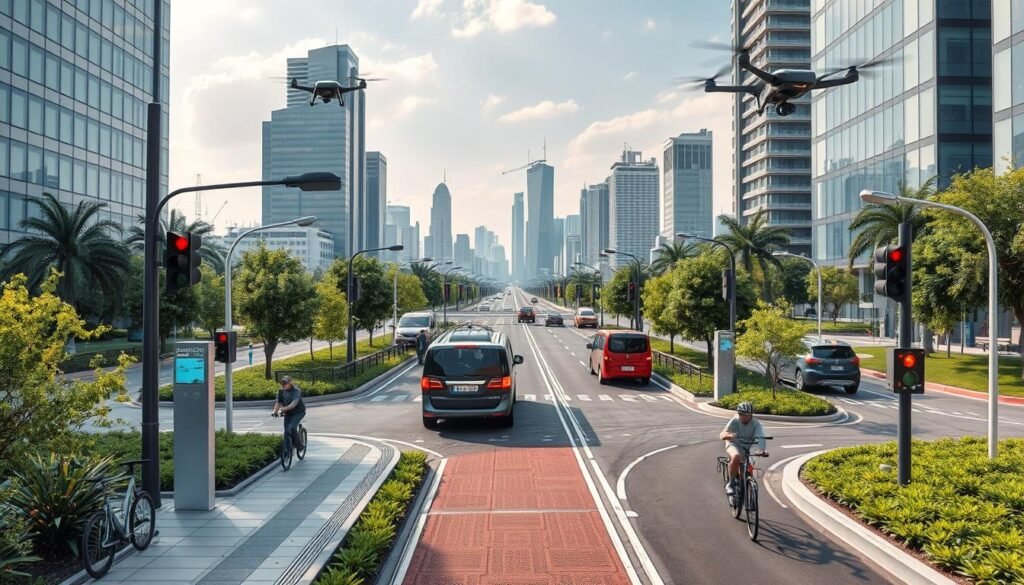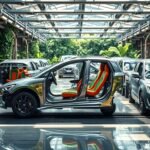The United Kingdom is on the verge of a big change in how we travel. Autonomous vehicles (AVs) are becoming more real. They will change how cities are made, built, and run. As these cars get better and more people accept them, UK cities will see big changes. This will bring new ways of moving around and making cities better for everyone.
In the UK, city planners and leaders are thinking hard about AVs. They are looking at how to change roads, improve traffic, and make cities easier to get around. The arrival of self-driving cars will change cities in ways we can’t even imagine yet. UK cities are ready to lead in using this new tech, making them better for now and the future.

Key Takeaways
- Autonomous vehicles are reshaping urban planning in the UK, presenting both challenges and opportunities for city development.
- Integrating self-driving technology into urban infrastructure and transportation networks requires careful planning and coordination.
- Smart city initiatives are closely tied to the adoption of autonomous cars, with the potential to enhance mobility, sustainability, and quality of life.
- The impact of autonomous cars on urban planning extends beyond transportation, affecting factors such as parking, street design, and land use.
- Policymakers and city planners in the UK are at the forefront of adapting to the new realities presented by self-driving vehicles, leading the way in shaping the cities of the future.
Understanding Autonomous Vehicles and Smart City Integration
The world is moving towards a future with self-driving vehicles. It’s key to know the tech behind them and how they fit into our cities. Self-driving cars use sensors, software, and algorithms to drive without us.
Key Components of Self-Driving Technology
Advanced sensors like cameras, radar, and LiDAR are at the core of self-driving cars. They work together to understand the world around them. Powerful computers then use this data to make decisions on the fly.
Integration Challenges with Existing Infrastructure
Adding self-driving cars to our roads is tough. Our roads, traffic signals, and signs were made for humans, not cars that drive themselves. It’s important for self-driving cars to talk to the roads and signs to work well together.
Smart City Connectivity Requirements
- Robust, high-speed wireless communication networks (5G and beyond)
- Centralized traffic management systems to coordinate the flow of autonomous vehicles
- Real-time data exchange between vehicles, infrastructure, and city-wide sensors
- Secure and resilient cybersecurity measures to protect the entire system
Knowing how self-driving cars work and what they need to connect to cities is crucial. This knowledge helps city planners and officials imagine a future where cars and other transport work together. This future will make cities better, greener, and more livable.
The Impact of Autonomous Cars on Urban Planning
Urban planning is changing with the arrival of self-driving cars. Cities are transforming in big ways. Self-driving cars are changing how we use public spaces, leading to new urban planning ideas.
One big change is the need for less parking. With more shared rides and on-demand transport, we might own fewer cars. This means we could use that space for parks, homes, or community areas, making cities better places to live.
Autonomous cars also help traffic flow better and cut down on jams. This lets urban planners design streets that are better for walking and change how roads are used during the day.
| Key Impacts of Autonomous Cars on Urban Planning | Potential Benefits |
|---|---|
| Reduced need for parking infrastructure | Repurposing of land for community-focused amenities |
| Improved traffic flow and reduced congestion | Flexible street design and pedestrian-friendly zones |
| Increased integration of transportation modes | Seamless connectivity and enhanced mobility options |
Autonomous cars also help mix different ways to get around, like buses, ride-sharing, and bikes. This makes moving around cities easier and more connected.
As cities start to use self-driving cars, leaders and planners face new challenges and chances. By using these cars, cities can become more livable, green, and welcoming to everyone.
“The integration of autonomous vehicles will fundamentally reshape the way we design and experience our cities, presenting both challenges and opportunities for urban planners.”
Transforming City Streets and Parking Spaces
Urban mobility is changing with the rise of self-driving cars. This change is transforming how we design streets and parking. It’s making cities more sustainable and friendly for walkers.
Reimagining Parking Infrastructure
Self-driving cars might soon make owning a car less necessary. This means cities can rethink parking. New ideas like multi-purpose parking and automated valet systems could save space and look better.
Dynamic Street Design Solutions
Dynamic street design is set to change how we see cities. It lets streets change to fit different needs, like cars, buses, bikes, and walkers. Smart sensors and data help streets adjust to keep traffic flowing well.
Pedestrian-Friendly Zones in the Age of Self-Driving Cars
Self-driving cars could make cities better for people walking. By making some areas car-free, cities can create lively spots for people. These areas encourage walking, biking, and socializing, making cities better places to live.
As self-driving cars become common, it’s time for cities to change. By updating parking, streets, and areas for walkers, we can make cities better. This will improve how we move around and make cities more lively.
Vehicle-to-Everything (V2X) Technology: Building Connected Cities
Urban areas are changing fast, and V2X technology is key to making cities smarter. It lets vehicles talk to each other and the city’s systems. This makes traffic better, safer, and more efficient.
V2X technology lets vehicles share data with the city. They can talk to traffic lights, street lights, and other vehicles. This helps traffic flow smoothly and keeps everyone safe, including pedestrians and cyclists.
V2X technology can also cut down on accidents. Vehicles can see dangers they can’t see themselves. They warn other cars, making the city safer for everyone.
| Key Components of V2X Technology | Benefits for Smart Cities |
|---|---|
| Vehicle-to-Vehicle (V2V) communication Vehicle-to-Infrastructure (V2I) communication Vehicle-to-Pedestrian (V2P) communication Vehicle-to-Network (V2N) communication | Improved traffic flow and reduced congestion Enhanced safety through collision avoidance Optimized use of transportation infrastructure Seamless integration of various city systems |
As cities adopt vehicle-to-everything (v2x) technology, they’re changing fast. Connected vehicles and smart city systems make cities better. They become more efficient, sustainable, and enjoyable for everyone.
“The integration of V2X technology is not just about improving transportation, but about creating a more interconnected and responsive urban environment that enhances the overall quality of life for city dwellers.”
Mobility-as-a-Service (MaaS) and Urban Transportation Networks
In today’s world, Mobility-as-a-Service (MaaS) is changing how we get around cities. It combines public transit, ride-hailing, car-sharing, and self-driving cars into one easy service. This new way aims to make travel better and greener, meeting the needs of city folks.
Integration with Public Transit Systems
MaaS works well with public transit. Self-driving cars help connect people to the nearest bus or train. This makes getting around cities easier and greener, pushing people towards better travel choices.
Subscription-Based Transportation Models
New MaaS services offer a monthly or yearly fee for all sorts of travel. This makes traveling cheaper and more flexible. It lets city dwellers pick the best way to travel without owning a car.
Last-Mile Connectivity Solutions
Self-driving cars are key in solving the last-mile problem in cities. They take people from transit points to their final stops. This cuts down on car use and boosts a sustainable transportation system.
| Feature | Benefit |
|---|---|
| Integrated Mobility Options | Improved accessibility and convenience for urban residents |
| Subscription-Based Pricing | Increased affordability and flexibility in transportation choices |
| Last-Mile Connectivity | Reduced reliance on private cars and enhanced urban mobility |

Cities are working to be better and greener, and MaaS and self-driving cars are key. They connect different travel ways and solve the last-mile issue. This leads to better and greener travel for everyone.
Sustainable Urban Development with Autonomous Vehicles
Cities around the world are working towards a greener future. Autonomous vehicles (AVs) play a big role in this effort. They can make cities in the UK more efficient and livable.
AVs help reduce harmful emissions and support green transportation. They optimize routes, cut down on idling, and encourage eco-friendly driving. This helps the UK meet its goals for sustainable urban planning and smart cities.
AVs also work well with renewable energy and smart grids. This partnership helps cities use energy better and adopt clean energy. It makes cities more efficient and environmentally friendly.
AVs can also change how cities look. They reduce the need for parking, freeing up space for parks, walkways, and community areas. This makes cities more livable and walkable, focusing on people’s needs.
“Autonomous vehicles have the potential to be a game-changer in sustainable urban development, paving the way for greener, more efficient, and livable cities in the UK.”
As the UK welcomes AVs, they will help create better cities. This will bring together environmental care, community well-being, and new technology. It will lead to smart and sustainable cities.
Traffic Management Systems for Self-Driving Cars
As self-driving cars become common in cities, better traffic management systems are essential. These systems help make city traffic smoother and integrate self-driving cars into smart cities.
AI-Powered Traffic Flow Optimization
Artificial intelligence (AI) is changing how we manage traffic. It uses complex algorithms to analyze data from sensors and vehicles. This helps adjust traffic signals and roads for better flow.
AI makes traffic more efficient, cutting down travel times and emissions. It also makes driving smoother for both self-driving and human-driven cars.
Emergency Response Integration
Safety is key in city traffic. Systems for self-driving cars work well with emergency services. They quickly respond to accidents, alerting authorities and keeping everyone updated.
Real-Time Route Adjustment Systems
Self-driving cars can change routes based on traffic. These systems use real-time data to find the best paths. This helps reduce traffic congestion and makes cities more mobile.
| Feature | Benefit |
|---|---|
| AI-Powered Traffic Flow Optimization | Enhances efficiency, reduces travel times, and minimizes emissions |
| Emergency Response Integration | Improves safety and coordination in emergency situations |
| Real-Time Route Adjustment Systems | Alleviates traffic congestion and improves overall urban mobility |
As autonomous vehicles change city transport, strong traffic management systems are vital. They use AI, emergency response, and dynamic routing. These systems are key to better urban mobility and a better driving experience for everyone.

Economic Implications for Urban Development
Autonomous vehicles are changing cities in big ways. City planners must think about the economic effects. These changes can bring both challenges and chances for growth.
One big change is in parking. With fewer cars, cities can use this space for other things. This could be parks, homes, or shops. It could also increase the value of land and create new jobs.
| Economic Factors | Potential Impact of Autonomous Vehicles |
|---|---|
| Land Use Value | Increased value due to repurposing of parking spaces |
| Job Market | Decline in jobs related to traditional transportation (e.g., taxi, rideshare, and delivery drivers), offset by new opportunities in technology, infrastructure, and service industries |
| Business Opportunities | Growth in mobility-as-a-service (MaaS) providers, transportation technology companies, and shared mobility services |
Autonomous vehicles also open up new business areas. This includes MaaS platforms and shared mobility services. These can make cities better and more efficient for everyone.
As cities move towards autonomous vehicles, leaders face big decisions. They must balance the challenges and chances for a better future.
“The future of transportation is autonomous, and cities that embrace this change will thrive in the years to come.”
Safety and Security Considerations in Autonomous Urban Planning
Urban planning is now focusing on the benefits of self-driving cars. It’s vital to make sure these cars are safe and secure. This includes setting up strong cybersecurity and emergency plans.
Cybersecurity Infrastructure Requirements
Self-driving cars use advanced tech, making them a target for hackers. It’s crucial to protect their data and functions. This means using strong encryption and secure communication.
Also, we need to have systems in place to catch and stop cyber threats. This keeps our transportation network safe and reliable.
Emergency Protocol Implementation
When emergencies happen, it’s key for self-driving cars and emergency teams to work together smoothly. Urban planners need to create detailed plans for these situations. This includes sharing data in real-time and coordinating responses quickly.
Public Safety Integration Measures
- Dedicated pedestrian and cyclist safety zones to minimize the risk of collisions
- Robust vehicle-to-everything (V2X) communication systems to enhance situational awareness and collision avoidance
- Comprehensive public education and awareness campaigns to promote safe interactions with autonomous vehicles
By focusing on safety and security, we can make sure self-driving cars are good for everyone. A careful and detailed approach to planning is needed. This way, we can use new tech to make our cities better and safer for all.
| Cybersecurity Measure | Description |
|---|---|
| Encryption | Implement robust encryption protocols to protect sensitive vehicle and infrastructure data |
| Secure Communication | Establish secure, encrypted communication channels between autonomous vehicles and urban infrastructure |
| Threat Detection | Deploy advanced threat detection and mitigation systems to identify and address cyber threats in real-time |
Future-Proofing Cities for Autonomous Transportation
As urban planning and smart cities evolve, they need to be ready for sustainable transportation. Cities must prepare their infrastructure and policies for a future with autonomous vehicles. This means thinking ahead to adapt to new mobility patterns.
To make cities ready for autonomous transport, urban planners should focus on a few key areas:
- Flexible Street Designs: Create street layouts that can change to fit different vehicles. This includes making sure pedestrians and cyclists are safe.
- Adaptive Parking Solutions: Update parking to be more flexible. Instead of fixed lots, use shared spaces that can change as needed.
- Intelligent Traffic Management: Use artificial intelligence and vehicle-to-everything (V2X) technology to manage traffic better. This helps reduce jams and keeps traffic moving smoothly.
- Integrated Mobility Networks: Connect autonomous vehicles with public transit and other Mobility-as-a-Service (MaaS) options. This gives people many ways to get around.
- Cybersecurity and Data Privacy: Make sure the systems are safe and protect user data. This is crucial for keeping everything secure.
By using these strategies, cities can get ready for the future. They can become sustainable and ready for the big changes that autonomous vehicles will bring.
“The future of urban planning lies in creating flexible, resilient cities that can evolve alongside the rapid advancements in autonomous transportation technology.”
Conclusion
The impact of autonomous cars on urban planning is truly transformative. Self-driving technology is changing cities, transportation, and how we use our spaces. It’s a big change.
Things like V2X connectivity and Mobility-as-a-Service (MaaS) are making urban mobility autonomous. Cities that adapt to this change will offer better access, less traffic, and a greener life.
But, there are challenges like cybersecurity and emergency plans. Cities need to tackle these issues. With the right leadership and innovation, cities can become better places for everyone.
FAQ
What are the key components of self-driving technology that are enabling autonomous vehicles?
Self-driving tech includes sensors like cameras, radar, and lidar. It also has advanced control systems and AI. Plus, high-precision GPS and V2X communication are key.
What are the main challenges in integrating autonomous vehicles with existing urban infrastructure?
Making cities ready for self-driving cars is tough. We need to update roads, signals, and systems. Also, keeping data safe and working with old systems is a big deal.
How are autonomous vehicles reshaping urban planning and design principles?
Self-driving cars are changing how we plan cities. We need flexible parking and streets that are safe for all. They also help with public transport and getting people where they need to go.
What is the role of vehicle-to-everything (V2X) technology in creating connected and smart cities?
V2X tech lets cars talk to each other and the city. It makes traffic better, keeps us safe, and makes transport more efficient.
How is mobility-as-a-service (MaaS) transforming urban transportation models?
MaaS combines self-driving cars with public transport. It offers a new way to get around, making cities more mobile and less car-dependent.
What are the sustainable development benefits of integrating autonomous vehicles into urban environments?
Self-driving cars can make cities greener. They cut down emissions and use energy wisely. They also support green projects like electric charging stations.
How are autonomous vehicles impacting traffic management systems in cities?
Self-driving cars are improving traffic management. They use AI and V2X to make traffic flow better. They also help in emergencies and adjust routes for a smoother ride.
What are the key economic implications of autonomous vehicles for urban development?
Self-driving cars change how we use land and create jobs. They open up new business areas like shared transport and logistics.
What are the key safety and security considerations for autonomous urban planning?
Keeping self-driving cars safe is crucial. We need strong cybersecurity, emergency plans, and public safety features like better lights and signs.
How can cities future-proof their urban planning for autonomous transportation?
Cities should plan for change with flexible designs and scalable infrastructure. They need policies that can grow with self-driving tech.

